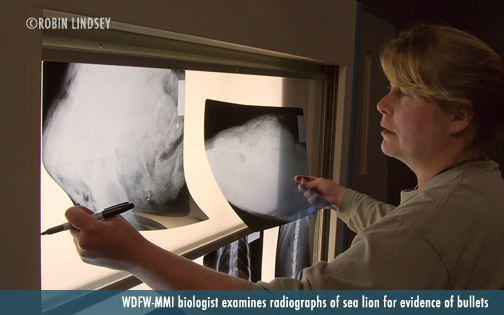NOAA WEST COAST MARINE MAMMAL STRANDING NETWORK (MMSN)
The Marine Mammal Health and Stranding Response Program (MMHRSP) was established in 1992 as an amendment to the Marine Mammal Protection Act (MMPA). Volunteer stranding networks, authorized and overseen by NOAA’s NMFS (National Marine Fisheries Service), were formed in all coastal states to respond to strandings.
NOAA's Marine Mammal Stranding Network is divided into five regions in the United States. Networks in California and the Pacifc Northwest, including Seal Sitters MMSN, are part of the West Coast Region. See below for links to maps showing response areas and contact information for networks in Washington, Oregon and California.
WHAT IS A STRANDING?
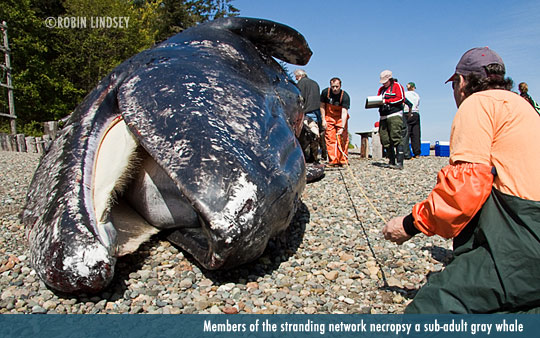 The term stranding means an event in the wild in which a marine mammal is dead on a beach or shore - or in the jurisdictional waters - of the United States.
The term stranding means an event in the wild in which a marine mammal is dead on a beach or shore - or in the jurisdictional waters - of the United States.
A stranding can also mean that a marine mammal is alive on a beach, shore or waters and:
a) unable to return to the water;
b) although able to return to the water, may be in need of medical assistance;
c) or unable to return to its natural habitat under its own power or without assistance.
In many stranding cases, the cause of the stranding is unknown, but some identified causes have included disease, parasite infestation, harmful algal blooms, injuries from ship strikes, fishing gear entanglements, pollution exposure, trauma, and starvation.
While most stranded animals are found dead, some do strand alive. In a limited number of cases it's possible to transport them to regional rehabilitation centers for care. Successfully rehabilitated animals are returned to the wild.
The gray whale in the banner image at the top of this page became marooned in shallow water as the tide receded. The whale was unable to swim back out into deeper water. Members of the stranding network kept the exposed animal wet and cool until the tide returned and the whale was able to swim free. The whale stranded again the following day. For a photo gallery with details, click here.
NETWORK RESEARCHERS PERFORM CRITICAL SCIENCE
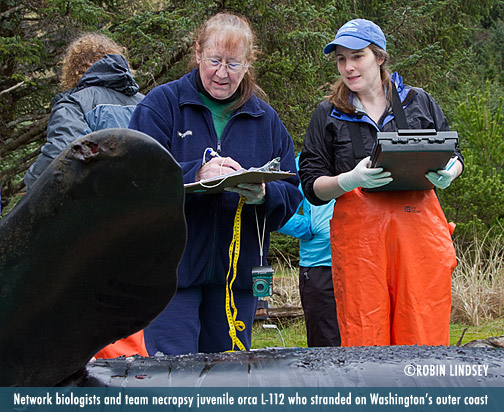 NNOAA West Coast MMSN members perform vital research into causes of mortality and emerging diseases in marine mammals. This enables biologists to monitor the health of species populations and identify threats.
NNOAA West Coast MMSN members perform vital research into causes of mortality and emerging diseases in marine mammals. This enables biologists to monitor the health of species populations and identify threats.
Necropsies are performed on fresh-dead animals whenever possible. Blood serum, blubber and tissue tests reveal viral and contaminant loads and pathogens.
During examinations, biologists look for evidence of blunt force trauma, an indicator of ship strikes in large whales. Researchers are seeking ways to lessen deadly vessel/whale interaction in shipping lanes by studying behavior. In smaller cetaceans and pinnipeds, blunt force trauma might suggest an attack by transient orca.
Signs of entanglement and fishery interaction are other important findings. Gathering this data applies pressure for timely reporting by fisheries of marine mammal takes. Statistics of interactions compel fisheries to engage in safer fishing practices and encourage improvements and safer types of fishing gear, such as biodegradable monofilament line, escape cord for shellfish pots, and less dangerous bait packing bands which strangle marine mammals.
Each year, especially during the fall migrating fish runs, sea lions and harbor seals die from bullet wounds. Evidence is turned over to NOAA's Office of Law Enforcement (OLE) for criminal investigation.
Network members notify OLE in all cases of injury or death resulting from human interaction. Read about the 2012 investigation into multiple shootings of Puget Sound sea lions and a harbor seal on blubberblog.
VOLUNTEERS AND INTERNS PLAY AN IMPORTANT ROLE
Many of the marine mammal stranding networks across the country are largely volunteer, like Seal Sitters and Sno-King MMSR. Others, such as WDFW's Marine Mammal Investigations (WDFW-MMI) and Cascadia Research utilize interns, who support research biologists and scientists in both the field and lab (see below for a list of all stranding networks in the Northwest). These volunteers and interns donate thousands of hours a year.
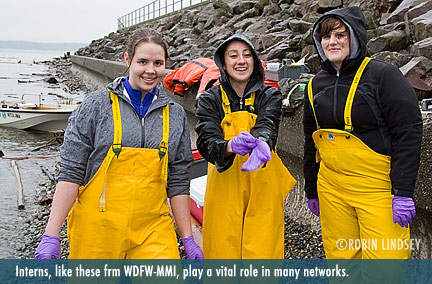 NETWORK VOLUNTEERS LESSEN NEGATIVE INTERACTIONS
NETWORK VOLUNTEERS LESSEN NEGATIVE INTERACTIONS
Not every animal on shore is stranded. Seals and sea lions spend approximately 50% of their day resting and warming up on shore, as well as on docks, rafts and buoys.
Stranding networks protect these resting animals from harassment and educate the public about species biology. This valuable service provides safety for both the public and marine mammal by lessening human interference.
By far, the marine mammal that is most often reported to network stranding hotlines is the harbor seal pup who's alone on the beach. In most cases, pups are just resting and not stranded. Unfortunately, only 50% of pups in the wild survive their first year. Not every seal pup with health concerns is eligible for rehab in the Pacific Northwest. With limited resources and healthy harbor seal population numbers, rehabilitation is generally reserved for cases of human interference or endangerment. Read about NOAA's policy on rehabilitation of harbor seal pups.
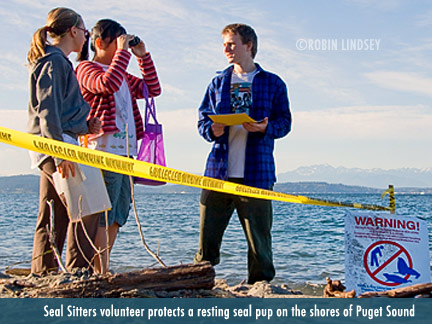 Never touch or handle a live or dead marine mammal as they can transmit diseases to human and dogs.
Never touch or handle a live or dead marine mammal as they can transmit diseases to human and dogs.
Please observe from a distance. Keep people and pets a safe distance away from all marine mammals (100 yards if possible) and call the proper authorities. Each day of rest could mean the difference between life and death for a harbor seal pup.
Remember, all marine mammals are protected by the Federal Marine Mammal Protection Act and Washington State law. For viewing and reporting guidelines for all marine mammals, visit NOAA's Be Whale Wise website.
The Marine Mammal Health and Stranding Response Program (MMHRSP) was established in 1992 as an amendment to the Marine Mammal Protection Act (MMPA). Volunteer stranding networks, authorized and overseen by NOAA’s NMFS (National Marine Fisheries Service), were formed in all coastal states to respond to strandings.
NOAA's Marine Mammal Stranding Network is divided into five regions in the United States. Networks in California and the Pacifc Northwest, including Seal Sitters MMSN, are part of the West Coast Region. See below for links to maps showing response areas and contact information for networks in Washington, Oregon and California.
WHAT IS A STRANDING?

A stranding can also mean that a marine mammal is alive on a beach, shore or waters and:
a) unable to return to the water;
b) although able to return to the water, may be in need of medical assistance;
c) or unable to return to its natural habitat under its own power or without assistance.
In many stranding cases, the cause of the stranding is unknown, but some identified causes have included disease, parasite infestation, harmful algal blooms, injuries from ship strikes, fishing gear entanglements, pollution exposure, trauma, and starvation.
While most stranded animals are found dead, some do strand alive. In a limited number of cases it's possible to transport them to regional rehabilitation centers for care. Successfully rehabilitated animals are returned to the wild.
The gray whale in the banner image at the top of this page became marooned in shallow water as the tide receded. The whale was unable to swim back out into deeper water. Members of the stranding network kept the exposed animal wet and cool until the tide returned and the whale was able to swim free. The whale stranded again the following day. For a photo gallery with details, click here.
NETWORK RESEARCHERS PERFORM CRITICAL SCIENCE

Necropsies are performed on fresh-dead animals whenever possible. Blood serum, blubber and tissue tests reveal viral and contaminant loads and pathogens.
During examinations, biologists look for evidence of blunt force trauma, an indicator of ship strikes in large whales. Researchers are seeking ways to lessen deadly vessel/whale interaction in shipping lanes by studying behavior. In smaller cetaceans and pinnipeds, blunt force trauma might suggest an attack by transient orca.
Signs of entanglement and fishery interaction are other important findings. Gathering this data applies pressure for timely reporting by fisheries of marine mammal takes. Statistics of interactions compel fisheries to engage in safer fishing practices and encourage improvements and safer types of fishing gear, such as biodegradable monofilament line, escape cord for shellfish pots, and less dangerous bait packing bands which strangle marine mammals.
Each year, especially during the fall migrating fish runs, sea lions and harbor seals die from bullet wounds. Evidence is turned over to NOAA's Office of Law Enforcement (OLE) for criminal investigation.
Network members notify OLE in all cases of injury or death resulting from human interaction. Read about the 2012 investigation into multiple shootings of Puget Sound sea lions and a harbor seal on blubberblog.
VOLUNTEERS AND INTERNS PLAY AN IMPORTANT ROLE
Many of the marine mammal stranding networks across the country are largely volunteer, like Seal Sitters and Sno-King MMSR. Others, such as WDFW's Marine Mammal Investigations (WDFW-MMI) and Cascadia Research utilize interns, who support research biologists and scientists in both the field and lab (see below for a list of all stranding networks in the Northwest). These volunteers and interns donate thousands of hours a year.

Not every animal on shore is stranded. Seals and sea lions spend approximately 50% of their day resting and warming up on shore, as well as on docks, rafts and buoys.
Stranding networks protect these resting animals from harassment and educate the public about species biology. This valuable service provides safety for both the public and marine mammal by lessening human interference.
By far, the marine mammal that is most often reported to network stranding hotlines is the harbor seal pup who's alone on the beach. In most cases, pups are just resting and not stranded. Unfortunately, only 50% of pups in the wild survive their first year. Not every seal pup with health concerns is eligible for rehab in the Pacific Northwest. With limited resources and healthy harbor seal population numbers, rehabilitation is generally reserved for cases of human interference or endangerment. Read about NOAA's policy on rehabilitation of harbor seal pups.

Please observe from a distance. Keep people and pets a safe distance away from all marine mammals (100 yards if possible) and call the proper authorities. Each day of rest could mean the difference between life and death for a harbor seal pup.
Remember, all marine mammals are protected by the Federal Marine Mammal Protection Act and Washington State law. For viewing and reporting guidelines for all marine mammals, visit NOAA's Be Whale Wise website.
LET CONGRESS KNOW YOU SUPPORT FUNDING FOR MARINE MAMMALS
NOAA's Marine Mammal Stranding Network is the first line of defense in response to catastrophic events, such as dolphin die-offs, sea lion unusual mortality events and whale entanglements - as well as just simply ensuring a lone seal pup is not harmed by a well-intentioned public. For an overview of the service performed by NOAA Marine Mammal Health and Stranding Response Program, click here.
Research and responses to marine mammal strandings are in large part funded by the John H. Prescott Fund. This funding has historically been reduced each year in the Federal budget.
Contact your senator or state representative, asking that this critical funding be maintained.
NOAA's Marine Mammal Stranding Network is the first line of defense in response to catastrophic events, such as dolphin die-offs, sea lion unusual mortality events and whale entanglements - as well as just simply ensuring a lone seal pup is not harmed by a well-intentioned public. For an overview of the service performed by NOAA Marine Mammal Health and Stranding Response Program, click here.
Research and responses to marine mammal strandings are in large part funded by the John H. Prescott Fund. This funding has historically been reduced each year in the Federal budget.
Contact your senator or state representative, asking that this critical funding be maintained.
CONTACT INFORMATION FOR NOAA WEST COAST MMSN
For a seal or other marine mammal on beaches in West Seattle (from Brace Point thru the Duwamish River,
including Harbor Island), call:
Seal Sitters MMSN Hotline @ 206-905-SEAL (7325)
For all other beaches in Washington and Oregon, please call:
NOAA West Coast MMSN Stranding Hotline: 1-866-767-6114
If you see harassment or if an animal is in danger, call:
NOAA Office of Law Enforcement @ 1-800-853-1964
Immediately afterwards, please notify your area stranding network (see map links with contact info below)
For entangled marine mammals, please call: 1-877-SOS-WHALE (1-877-767-9425)
or hail the U.S. Coast Guard on VHF ch 16.
MAPS OF MARINE MAMMAL STRANDING NETWORKS IN WASHINGTON AND OREGON
Download maps with contact information on the stranding network in your area:
NW Marine Mammal Stranding Network for Puget Sound
NW Marine Mammal Stranding Network for Washington
NW Marine Mammal Stranding Network for Oregon
MAPS OF MARINE MAMMAL STRANDING NETWORKS IN CALIFORNIA
Download maps with information on California networks:
Live animal strandings
Dead animal strandings
For a seal or other marine mammal on beaches in West Seattle (from Brace Point thru the Duwamish River,
including Harbor Island), call:
Seal Sitters MMSN Hotline @ 206-905-SEAL (7325)
For all other beaches in Washington and Oregon, please call:
NOAA West Coast MMSN Stranding Hotline: 1-866-767-6114
If you see harassment or if an animal is in danger, call:
NOAA Office of Law Enforcement @ 1-800-853-1964
Immediately afterwards, please notify your area stranding network (see map links with contact info below)
For entangled marine mammals, please call: 1-877-SOS-WHALE (1-877-767-9425)
or hail the U.S. Coast Guard on VHF ch 16.
MAPS OF MARINE MAMMAL STRANDING NETWORKS IN WASHINGTON AND OREGON
Download maps with contact information on the stranding network in your area:
NW Marine Mammal Stranding Network for Puget Sound
NW Marine Mammal Stranding Network for Washington
NW Marine Mammal Stranding Network for Oregon
MAPS OF MARINE MAMMAL STRANDING NETWORKS IN CALIFORNIA
Download maps with information on California networks:
Live animal strandings
Dead animal strandings
YOU CAN HELP!
VOLUNTEER WITH A STRANDING NETWORK
Stranding networks in the Pacific Northwest are always in need of reliable volunteers.
To learn more details about the networks in WA and OR, explore the websites below.
(download maps above for faster information about general response area and contact phone)
Washington
Seal Sitters Marine Mammal Stranding Network (SSMMSN)
Sno-King Marine Mammal Response
Edmonds Seal Sitters (not affiliated with SSMMSN)
Central Puget Sound Marine Mammal Stranding Network
MaST Center Stranding Team
Port Townsend Marine Science Center
Whatcom Marine Mammal Stranding Network
San Juan County Marine Mammal Stranding Network
World Vets MMSN
Feiro Marine Life Center
Dungeness National Wildlife Refuge
Cascadia Research Collective
Washington Department of Fish and Wildlife - Marine Mammal Investigations Unit
Olympic Coast National Marine Sanctuary
Oregon
Portland State University/Seaside Aquarium
Oregon State University Marine Mammal Institute
NOAA MMSN WEBSITES
West Coast Marine Mammal Stranding Network
NOAA Northwest Regional Office
Marine Mammal Health and Stranding Response Program (MMHSRP) (Nationwide)
VOLUNTEER WITH A STRANDING NETWORK
Stranding networks in the Pacific Northwest are always in need of reliable volunteers.
To learn more details about the networks in WA and OR, explore the websites below.
(download maps above for faster information about general response area and contact phone)
Washington
Seal Sitters Marine Mammal Stranding Network (SSMMSN)
Sno-King Marine Mammal Response
Edmonds Seal Sitters (not affiliated with SSMMSN)
Central Puget Sound Marine Mammal Stranding Network
MaST Center Stranding Team
Port Townsend Marine Science Center
Whatcom Marine Mammal Stranding Network
San Juan County Marine Mammal Stranding Network
World Vets MMSN
Feiro Marine Life Center
Dungeness National Wildlife Refuge
Cascadia Research Collective
Washington Department of Fish and Wildlife - Marine Mammal Investigations Unit
Olympic Coast National Marine Sanctuary
Oregon
Portland State University/Seaside Aquarium
Oregon State University Marine Mammal Institute
NOAA MMSN WEBSITES
West Coast Marine Mammal Stranding Network
NOAA Northwest Regional Office
Marine Mammal Health and Stranding Response Program (MMHSRP) (Nationwide)
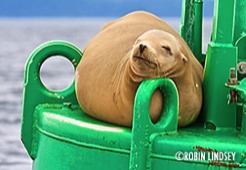
Boaters need to be careful not to disrupt marine mammals' behavior. Stay back from areas where seals and sea lions are resting, including buoys, and give swimming marine mammals space (the rules for orca viewing have changed recently). View Seal Sitters' boater guidelines PDF and visit NOAA's Be Whale Wise website.
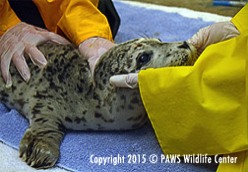
Not every seal pup is a candidate for rehabilitation.
Harbor seal populations are considered by biologists to be at healthy numbers and area resources are limited.
Learn more here about seal pups and NOAA's official policy on harbor seal pup rehabilitation.
